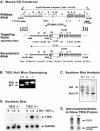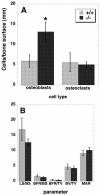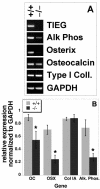TIEG1 null mouse-derived osteoblasts are defective in mineralization and in support of osteoclast differentiation in vitro
- PMID: 15657444
- PMCID: PMC543998
- DOI: 10.1128/MCB.25.3.1191-1199.2005
TIEG1 null mouse-derived osteoblasts are defective in mineralization and in support of osteoclast differentiation in vitro
Abstract
Transforming growth factor beta-inducible early gene 1 (TIEG1) is a member of the Kruppel-like transcription factor family. To understand the physiological role of TIEG1, we generated TIEG(-/-) (null) mice and found that the TIEG(-/-) mice had increased osteoblast numbers with no increased bone formation parameters. However, when calvarial osteoblasts (OBs) were isolated from neonatal TIEG(-/-) and TIEG(+/+) mice and cultured in vitro, the TIEG(-/-) cells displayed reduced expression of important OB differentiation markers. When the OBs were differentiated in vitro by treatment with bone morphogenic protein 2, the OBs from TIEG(+/+) calvaria displayed several mineralized nodules in culture, whereas those from TIEG(-/-) mice showed no nodules. To characterize the OBs' ability to support osteoclast differentiation, the OBs from TIEG(+/+) and TIEG(-/-) mice were cultured with marrow and spleen cells from TIEG(+/+) mice. Significantly fewer osteoclasts developed when TIEG(-/-) OBs were used to support osteoclast differentiation than when TIEG(+/+) OBs were used. Examination of gene expression in the TIEG(-/-) OBs revealed decreased RANKL and increased OPG expression compared to TIEG(+/+) OBs. The addition of RANKL to these cocultures only partially restored the ability of TIEG(-/-) OBs to support osteoclast differentiation, whereas M-CSF alone or combined with RANKL had no additional effect on osteoclast differentiation. We conclude from these data that TIEG1 expression in OBs is critical for both osteoblast-mediated mineralization and osteoblast support of osteoclast differentiation.
Figures








References
-
- Bieker, J. J. 2001. Krüppel-like factors: three fingers in many pies. J. Biol. Chem. 276:34355-34358. - PubMed
-
- Borton, A. J., J. P. Frederick, M. B. Datto, X. F. Wang, and R. S. Weinstein. 2001. The loss of Smad3 results in a lower rate of bone formation and osteopenia through dysregulation of osteoblast differentiation and apoptosis. J. Bone Miner. Res. 16:1754-1764. - PubMed
-
- Chalaeux, E., T. Lopez-Rovira, J. L. Rosa, Pons, G., L. M. Boxer, R. Bartrons, and F. Ventura. 1999. A zinc-finger transcription factor induced by TGFβ promotes apoptotic cell death in epithelial Mv1Lu cells. FEBS Lett. 457:478-482. - PubMed
-
- Cook, T., B. Gebelein, M. Belal, K. Mesa, R., and Urrutia. 1999. Three conserved transcriptional repressor domains are a defining feature of the TIEG1 subfamily of Sp1-like zinc finger proteins. J. Biol. Chem. 274:29500-29504. - PubMed
Publication types
MeSH terms
Substances
Grants and funding
LinkOut - more resources
Full Text Sources
Other Literature Sources
Molecular Biology Databases
Research Materials
Miscellaneous
